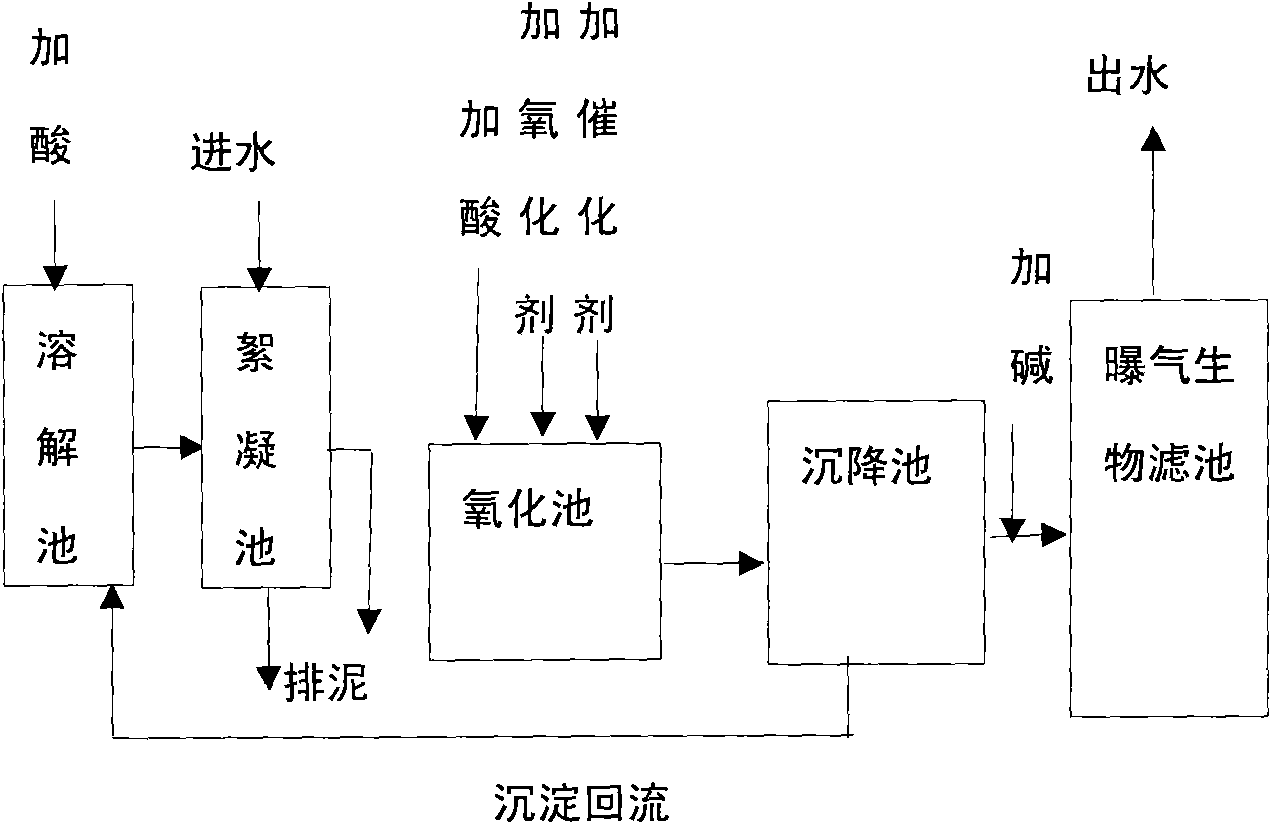Method for treating wastewater by combining catalytic oxidation with biological aerated filter
A biological aerated filter and catalytic oxidation technology, applied in the direction of sustainable biological treatment, biological water/sewage treatment, oxidized water/sewage treatment, etc., can solve the problems of industrial application limitations, large acid and alkali consumption, etc., and achieve reduction Acid and alkali consumption, reduction of treatment cost, effect of cost reduction
- Summary
- Abstract
- Description
- Claims
- Application Information
AI Technical Summary
Problems solved by technology
Method used
Image
Examples
Embodiment 1
[0030] To treat the non-standard effluent of an oil refinery, H 2 o 2 as an oxidizing agent, Fe 2 SO 4 As a catalyst, the acid and base used are concentrated H 2 SO 4 and NaOH. The operating conditions are: H 2 o 2 The ratio to the mass concentration of organic matter (COD) in wastewater is 1:3, H 2 o 2 / Fe 2+ The molar ratio is 1:2, the pH of the oxidation tank is 3, the pH of the supernatant of the sedimentation tank is 7, the pH of the dissolution tank is 0.3, the residence time of wastewater in the flocculation tank is 1 hour, the residence time of the oxidation tank is 60 minutes, and the residence time of the sedimentation tank is 1 hour. The time is 2 hours, and the residence time of the biological aerated filter is 4 hours. See Table 1 for the processing results. From the data in Table 1, it can be seen that after the wastewater is treated by catalytic oxidation, the COD and oil content are greatly reduced, and the biodegradability is significantly improved....
Embodiment 2
[0034] For the pretreatment of reverse osmosis influent water in the process of wastewater reuse in a refinery, H 2 o 2 as an oxidizing agent, Fe 2 SO 4 As a catalyst, the acid and base used are concentrated H 2 SO 4 and NaOH. The operating conditions are determined as: H 2 o 2 The ratio to the mass concentration of organic matter (COD) in wastewater is 1:2, H 2 o 2 / Fe 2+ The molar ratio is 1:1, the pH of the oxidation tank is 5, the pH of the supernatant of the sedimentation tank is 6.5, the pH of the dissolution tank is 0.5, the residence time of wastewater in the flocculation tank is 1 hour, the residence time of the oxidation tank is 40 minutes, and the residence time of the sedimentation tank is 1.5 hours, the residence time of biological aerated filter is 3 hours. From the data in Table 1, it can be seen that after the wastewater is treated by catalytic oxidation, the COD is greatly reduced, and the biodegradability is significantly improved. After the BAF tre...
Embodiment 3
[0038] Sodium hypochlorite was used as the oxidant to treat the unqualified wastewater discharged from a chemical plant, and Fe 2 SO 4 As a catalyst, the acid and base used are concentrated H 2 SO 4 and NaOH. The operating conditions are: the ratio of the mass concentration of sodium hypochlorite to the organic matter (COD) in the wastewater is 1:3, and the sodium hypochlorite / Fe 2+ The molar ratio is 1:1.5, the pH of the oxidation tank is 4, the pH of the supernatant of the sedimentation tank is 7.5, the pH of the dissolution tank is 0.3, the residence time of wastewater in the flocculation tank is 1 hour, the residence time of the oxidation tank is 60 minutes, and the residence time of the sedimentation tank is 1 hour. The time is 2 hours, and the residence time of the biological aerated filter is 4 hours. See Table 3 for the processing results. From the data in Table 3, it can be seen that after the wastewater is treated by catalytic oxidation, the COD and oil content ...
PUM
 Login to View More
Login to View More Abstract
Description
Claims
Application Information
 Login to View More
Login to View More - R&D
- Intellectual Property
- Life Sciences
- Materials
- Tech Scout
- Unparalleled Data Quality
- Higher Quality Content
- 60% Fewer Hallucinations
Browse by: Latest US Patents, China's latest patents, Technical Efficacy Thesaurus, Application Domain, Technology Topic, Popular Technical Reports.
© 2025 PatSnap. All rights reserved.Legal|Privacy policy|Modern Slavery Act Transparency Statement|Sitemap|About US| Contact US: help@patsnap.com

